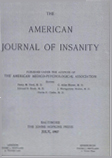ELECTROENCEPHALOGRAPHY IN THE PSYCHOSES
Abstract
The bilateral distribution of the amount of alpha-wave activity (per cent time alpha) from the cerebrum of 14 schizophrenics, two manic-depressives and one case of traumatic psychosis was determined.
From differences in the distribution of per cent time alpha over the two cerebral hemispheres, it was found possible to localize cerebral atrophy. The electroencephalographic diagnoses were confirmed pneumoencephalographically in eight of the nine schizophrenics and in both manic-depressive patients. Air injections have not yet been done on the other five schizophrenics.
In two of the schizophrenics with cerebral atrophy delta-wave discharges were occasionally observed. Epileptiform discharges were recorded from the forehead of one of the manic-depressive patients. The patient with traumatic psychosis had no detectable alpha rhythm, so that it was not possible to localize the extensive, marked cerebral atrophy, both deep and superficial, which were subsequently found pneumoencephalographically. However, potential changes typical of normal sleep were obtained while this patient was asleep.
Access content
To read the fulltext, please use one of the options below to sign in or purchase access.- Personal login
- Institutional Login
- Sign in via OpenAthens
- Register for access
-
Please login/register if you wish to pair your device and check access availability.
Not a subscriber?
PsychiatryOnline subscription options offer access to the DSM-5 library, books, journals, CME, and patient resources. This all-in-one virtual library provides psychiatrists and mental health professionals with key resources for diagnosis, treatment, research, and professional development.
Need more help? PsychiatryOnline Customer Service may be reached by emailing [email protected] or by calling 800-368-5777 (in the U.S.) or 703-907-7322 (outside the U.S.).



